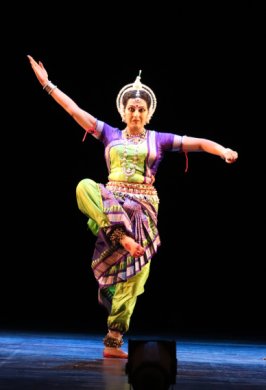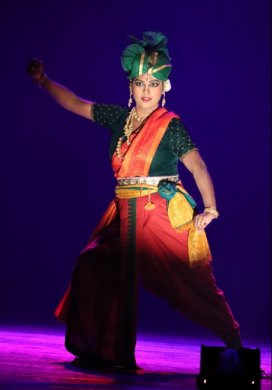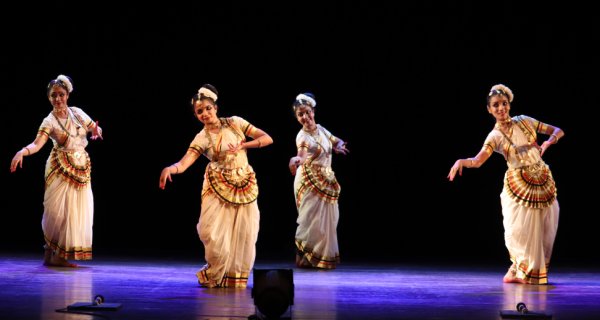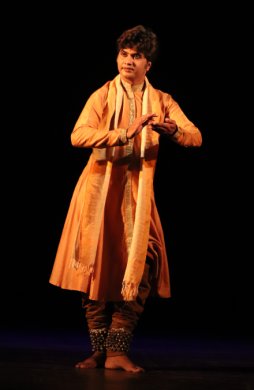
|   |

|   |
Manipuri Nartanalaya's Kala Utsav - Tapati Chowdhurie e-mail: tapatichow@yahoo.co.in August 22, 2022 Guru Kalavati besides being an accomplished vocalist with a vast knowledge of music, is also a mridangist and dancer. A complete artiste, she has trained generations of artistes not only in Manipuri dance, but has also taught them the life's lesson of living successful lives, a true guru in every sense of the word. Manipuri Nartanalaya's Kala Utsav was celebrated at Madhusudan Manch in Kolkata basically to venerate Guru Kalavati Devi, a name in Kolkata for her versatility, on her 80th birthday.  Arpita Venkatesh Odissi dancer Arpita Venkatesh's opening dance "Gururastakam" written by Shankaracharya was very significant. She humbly genuflected to the lotus feet of Guru Kalavati Devi sitting right in front before her recital. Arpita Venkatesh who was a disciple of Aloka Kanungo and is presently under Odissi exponent Sujata Mohapatra chose an apt number to show her respects to Guru Kalavati Devi. The song reiterated that it is the Guru who has the power to dispel darkness, the guru is more than someone who teaches specific type of knowledge, is an inspirational source and one who reveals the meaning of life. Arpita Venkatesh's rendition of the piece (Ragamalika and Talamalika) was in the impeccable Odissi style of Guru Kelucharan Mohapatra. The music was composed by Sukhamaya Bhattacharya. Kishore Ghosh accompanied the dancer on mardala. Dinesh Pal's vocal rendition added flavour to the piece. Dance composition and choreography was by Arpita Venkatesh. Arpita's second presentation 'Navagraha' was about the nine planets, which she based on Vyas Deva's Navagraha Stotra. She ably explained in dance vocabulary the benefits of chanting this stotra. The benefits of bowing down to the planets Ravi, Shashi, Mangal, Budh, Bhargav, Guru, Shani, Rahu and Ketu was shown symbolically. Arpita's special forte is creating her own compositions rather than presenting pieces she has learnt from her gurus. The musical score was composed by Himangshu Shekhar Swain, while rhythm composition was by Bhudhanath Swain and Muralidhar Swain based on Ragamalika, Talamalika.  Arpita Saha Arpita Saha, a student of Manipuri Nartanalaya, described Krishna's beauty and grace in 'Madhura Nartan' composed by Manipuri exponent Bimbavati Devi. The dance based on the lasya aspect of Manipuri dance has been composed on the ritualistic dance of Manipur. Much of the traditional music has been woven into it by Kalavati Devi. Vocalist N. Romilla Devi and pung player Th. Brojen Kumar Singha helped to create the fluidity of the piece. Krishna's beauty described in the word language of the poet has been translated into Manipuri dance in all its beauty. 'Purna Purushottam' composed by Bimbavati Devi on Vishnu's Narasimha Avatar who establishes dharma had all the high drama and fury composed in tandava style with blood and gore, a cathartic element with the indirect plea to wash clean the negative elements from our minds. This piece which is a group rendition was performed solo with no less an appeal. The choice of the two pieces displayed the adeptness of Bimbavati Devi in handling both the lasya and the tandava style of dance. Arpita Saha displayed her mettle.  Natyanova ensemble Repertory members of Natyanova added to the mood of the evening with a dance and an abhinaya piece. "Bho Shambho Shiva Shambho" in ragam Revathi and adi talam, sung melodiously by Lakshmi Narayanswamy and choreographed by Priyadarshini Ghosh, praising and describing the physical beauty of the Supreme Consciousness or Shiva in Mohiniattam style was rather unusual. Mohiniattam's grace was creatively used to showcase the masculinity of Shiva. As devotees of Shiva the dancers were able to describe him with authenticity. The dance composition was devised in a way that facilitated the description of Shiva whose dance epitomizes tandava style. The abhinaya piece "Lalita lavanga" was an ashtapadi from Jayadeva's Gita Govinda in ragam Mallika and Chempada talam in Carnatic style, to a music composition of Thankam Raja Gopala. Beautifully clad dancers in typical Mohiniattam style described springtime, when Radha is desperately looking for Krishna. The delicate description of the beauties of the spring season and how Krishna is frolicking in the woods of the Yamuna with other gopis was described with elegance and grace.  Sandip Mallick Kathak dancer of repute Sandip Mallick commenced his recital with Guru bhajan composed by Pt. Birju Maharaj followed by the Guru sloka "Dhyana mulam Guru murti, Puja mulam Guru padam, mantram mulam Guru vakyam, Moksha mulam Guru kripa" (The root of meditation is the Guru's form; The roots of worship is the Guru's feet; The roots of mantra are the words of the Guru; The root of liberation is the grace of the Guru). He then proceeded with 'Nad Vandana' where he created a soundscape with the reference of different elements related to lord Shiva by using no other musical instruments other than the ankle bells/ghungroo he was wearing. In pure dance he used the reference of five elements in thaat followed by paran jodi aamad. He paid his tribute to the great gurus of all the four gharanas - Lucknow, Jaipur, Banaras and Raigarh - in drut laya and presented a few gintis of different combinations of 13. Ending with Nayak beda through footwork was a fitting finale. The festival was supported by Sangeet Natak Akademi.  Tapati Chowdhurie trained under Guru Gopinath in Madras and was briefly with International Centre for Kathakali in New Delhi. Presently, she is a freelance writer on the performing arts. |